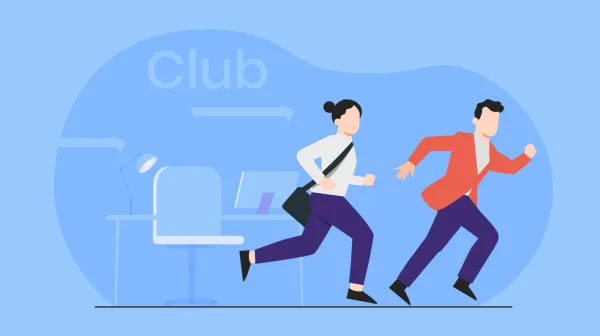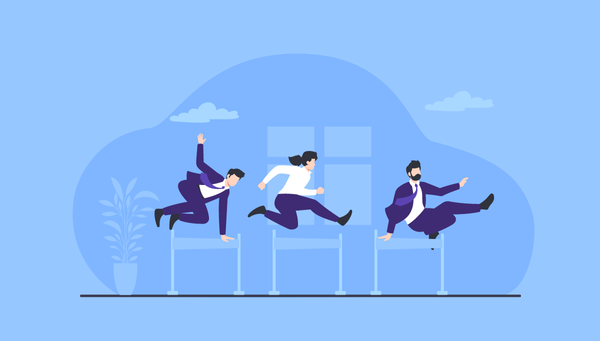12 Quick 5-Minute Wellness Activities That Boost Focus and Employee Engagement
Long workdays and screen fatigue take a clear toll on employees. Despite that, everyone is hustling to deliver their targets, without giving much thought to how constant sitting and screen time are hampering their lifestyle.
Burnout, chronic illness, loss of productivity, and an increase in presenteeism are some of the repercussions of such an unhealthy relationship with work. This is one of the reasons behind the growing market for corporate wellness.
However, the fact is that employee wellness doesn't always require hour-long workshops or expensive programs. Sometimes, the smallest actions create the most significant impact.
It just takes some microbreaks to restore focus, reduce fatigue, and improve your employees' mood. Micro-breaks, which are mostly short 5-minute pauses, are a proven antidote to stress. Micro breaks in this case include 5-minute wellness activities such as desk stretches, deep breathing, and chair yoga.
Research indicates that taking frequent, brief can enhance mental health and foster a positive work environment. Did you know? A 5-minute break each hour can increase productivity by about 40%.
The best thing about 5-minute wellness activities is that they are scalable, inclusive, and easy for HR to integrate into existing wellness programs. Here are 12 quick 5-minute wellness activities you can introduce at work today:
-
Desk stretches
-
Box breathing
-
Chair yoga
-
Eye relaxation break
-
Short walks
-
Hydration pauses
-
Healthy snack break
-
Quick art and craft
-
Brain teasers
-
Desk push-ups or chair squats
-
Social connection break
Looking to host these activities anytime soon?
Until then, let's break down these 12 5-minute activities that employees can easily try at work.
12 Quick and Effective 5-minute Wellness Activities
1. Desk stretches

What is it: These are a series of desk-friendly stretching exercises that release muscle tension from long hours of sitting.
How to do it:
-
Sit up straight with your feet flat on the floor.
-
Tilt your head slowly to each shoulder. As you tilt towards one side, hold the pose for 5–10 seconds.
-
Roll both shoulders backward in a circular motion. Rotate your shoulders forward as well.
-
Twist your torso to the right and left while seated. As you twist your torso to the right, bring your hands together and place them on the armrest of your chair. Repeat the same on the other side.
-
Stand up, bend forward from the waist, and breathe deeply. Maintain that posture for 5 seconds, then release. Repeat 5 times.
Benefits:
-
Reduces neck and shoulder pain from prolonged sitting.
-
Improves posture and spinal health.
-
Increases blood circulation and alertness.
Rollout tips for HR:
Encourage stretching before long meetings. Share a quick one-pager with infographics. Establish an official communication channel to post brief GIFs and infographics.
Accessibility/safety note:
Emphasize gentle movements and remind participants to stop if they experience any pain or discomfort.
2. Box Breathing
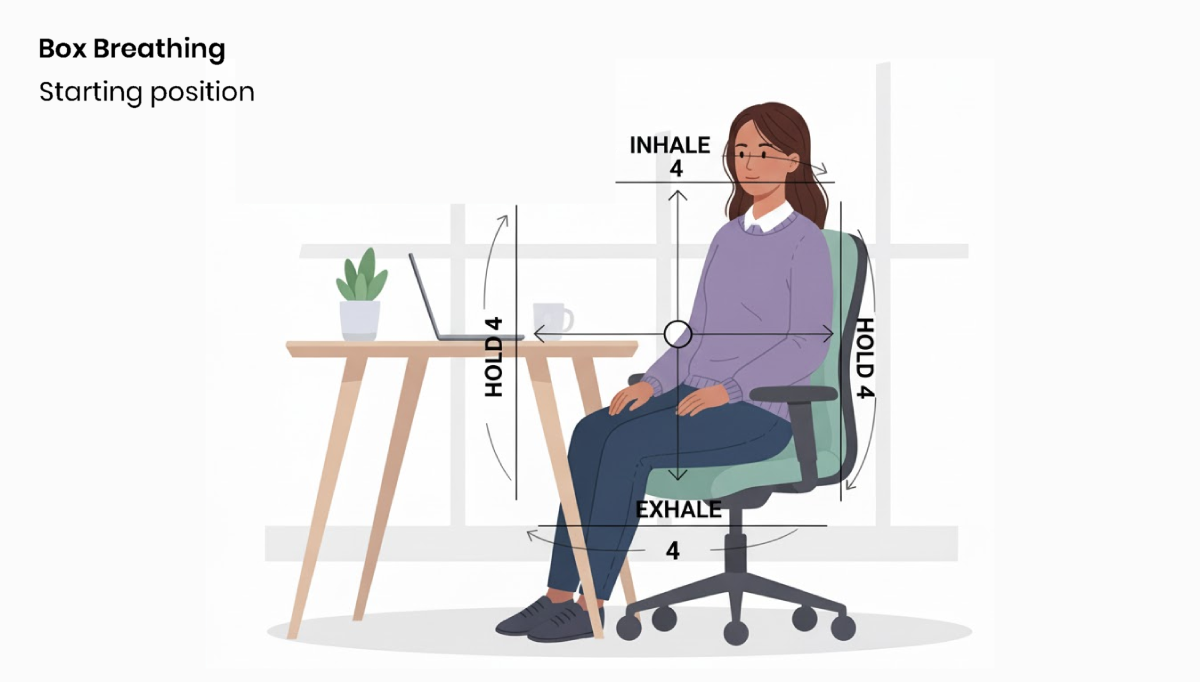
What is it: Box breathing is a structured breathing technique that provides immediate stress relief. It helps create a rhythmic breathing pattern that calms the mind and body. Box breathing is beneficial during a stressful situation.
How to do:
-
Sit comfortably with your back straight and feet flat on the floor.
-
Exhale through your mouth to start with empty lungs.
-
Inhale slowly through your nose for a count of 4.
-
Hold your breath for a count of 4.
-
Exhale slowly through your mouth for a count of 4.
-
Hold your breath for 4 counts before repeating the cycle again. Practice 4 to 6 cycles.
Benefits:
-
Activates the parasympathetic nervous system for immediate stress reduction.
-
Lowers blood pressure and heart rate.
-
Improves focus and mental clarity as this exercise increases oxygen flow to the brain.
-
Provides instant anxiety relief and emotional regulation.
Rollout tips for HR:
Share guided breathing exercise video or audio clips. Encourage teams to start meetings with 2 minutes of box breathing. Train managers to model and suggest breathing breaks during high-pressure situations.
Accessibility/safety note:
One can adjust the number of counts based on their lung capacity and comfort levels. Provide alternatives for employees with respiratory conditions and emphasize listening to their body's limits.
3. Chair yoga
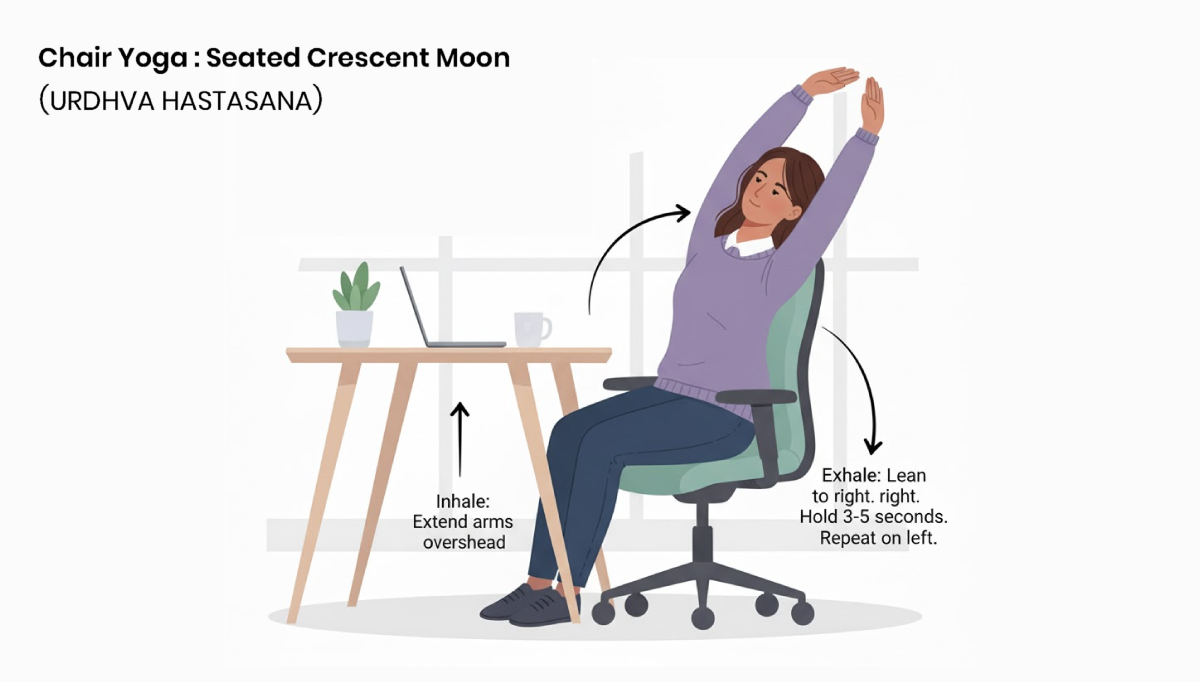
What is it: It is a modified form of yoga suitable for desk-bound employees. There are several chair yoga poses for busy professionals. I have listed one of the most effective chair yoga poses below.
Seated Crescent Moon (URDHVA HASTASANA)
How to do:
-
Sit straight up in your chair with both feet flat on the floor.
-
Inhale deeply and extend both arms over your head. The palms should face each other.
-
Clasp your hands together and keep them shoulder-width apart.
-
As you exhale, gently lean to the right side, feeling a stretch along your left rib cage and waist. Hold for 3–5 seconds and relax.
-
Return to center on an inhale, then lean to the left side and repeat the movement.
Benefits:
-
Relieves tension in the overall body and spine.
-
Improves posture and spinal flexibility.
-
Relaxes the chest and lung muscles for deeper breathing.
-
Boosts energy and focus after long periods of sitting.
Rollout tips for HR:
-
Introduce Seated Crescent Moon as a quick "meeting opener" to reset posture and focus.
-
Share a short instructional video or GIF on your official communication channel so that employees can easily follow along.
-
Incorporate it into a "5-minute chair yoga" sequence during Wellness Wednesdays or employee wellness days.
Accessibility/safety note:
-
Encourage employees to stretch only as far as comfortably without straining.
-
Offer the option to keep hands shoulder-width apart (instead of clasped) for those with shoulder tightness.
-
Works well for both office and remote employees since it requires only one chair.
4. Eye relaxation break

What is it: It is simply an eye strain reduction technique, also known as the 20-20-20 rule.
How to do:
-
Look 20 feet away every 20 minutes for 20 seconds.
-
Gently roll eyes clockwise and counterclockwise.
-
Rub palms together and cup them over closed eyes.
Benefits:
-
Relieves digital eye strain.
-
Prevents headaches.
-
Protects eye health.
Rollout tips for HR:
- Use screen pop-ups or Teams reminders every 90 minutes: "Time for an eye break."
Accessibility/safety note:
Works in both office and remote setups.
5. Short walks
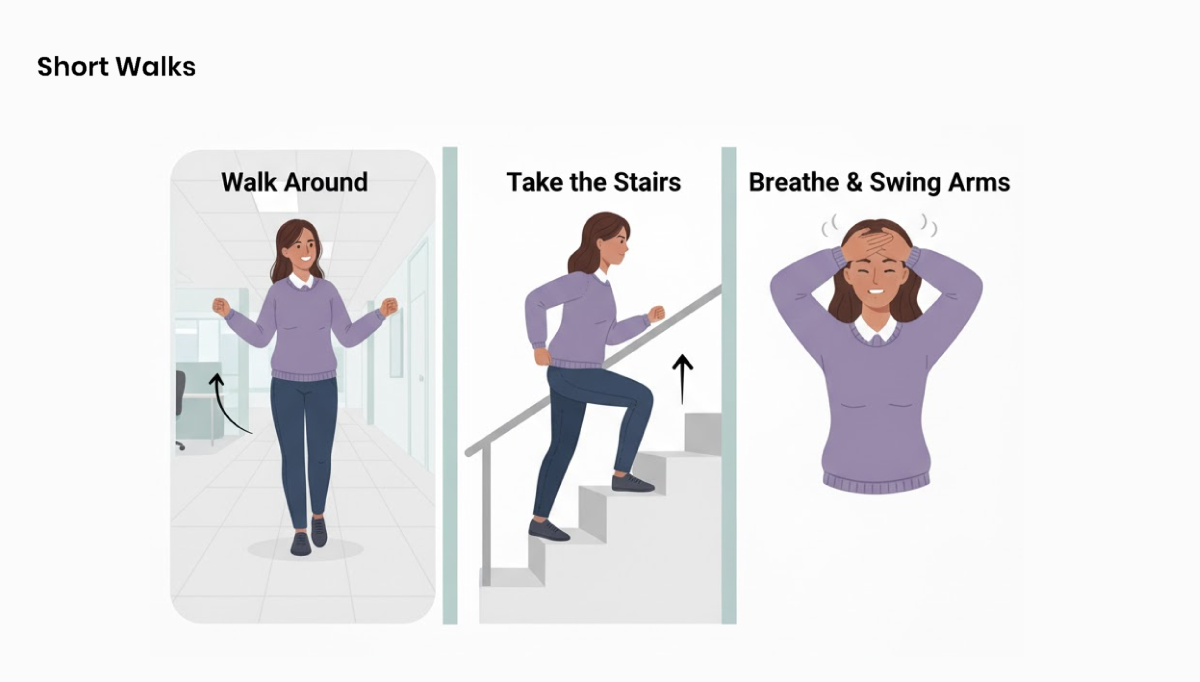
What is it: As the term suggests, it simply involves stepping out of the workspace and walking briefly.
How to do:
-
Step out of the workspace and take a walk around the office or outside.
-
Breathe deeply and swing your arms.
-
Choose stairs over elevators for a mini adrenaline boost.
Benefits:
-
Recharges energy levels.
-
Boosts blood circulation.
-
Encourages creative thinking.
Rollout tips for HR:
Promote walking meetings and introduce step challenges to encourage a walking mindset. Introduce wellness platforms like Vantage Fit to host such initiatives for better engagement and results.
6. Hydration pauses
What is it: A Hydration pause simply refers to a quick break to drink refreshments or water and reset.
How to do:
-
Keep your laptop away or walk away from the workspace for 5 minutes.
-
Take your choice of refreshments. It can be water, any kind of tea, or another refreshing drink.
-
Clear your mind from all the work chaos and just have a drink to replenish your body.
Benefits:
-
Prevents fatigue and headaches.
-
Improves brain function.
-
Supports metabolism and focus.
Rollout tips for HR:
- Install hydration stations or send fun "hydration nudges" through the communication channels.
Accessibility/safety note:
Provide infused water or herbal teas.
7. Healthy snack break
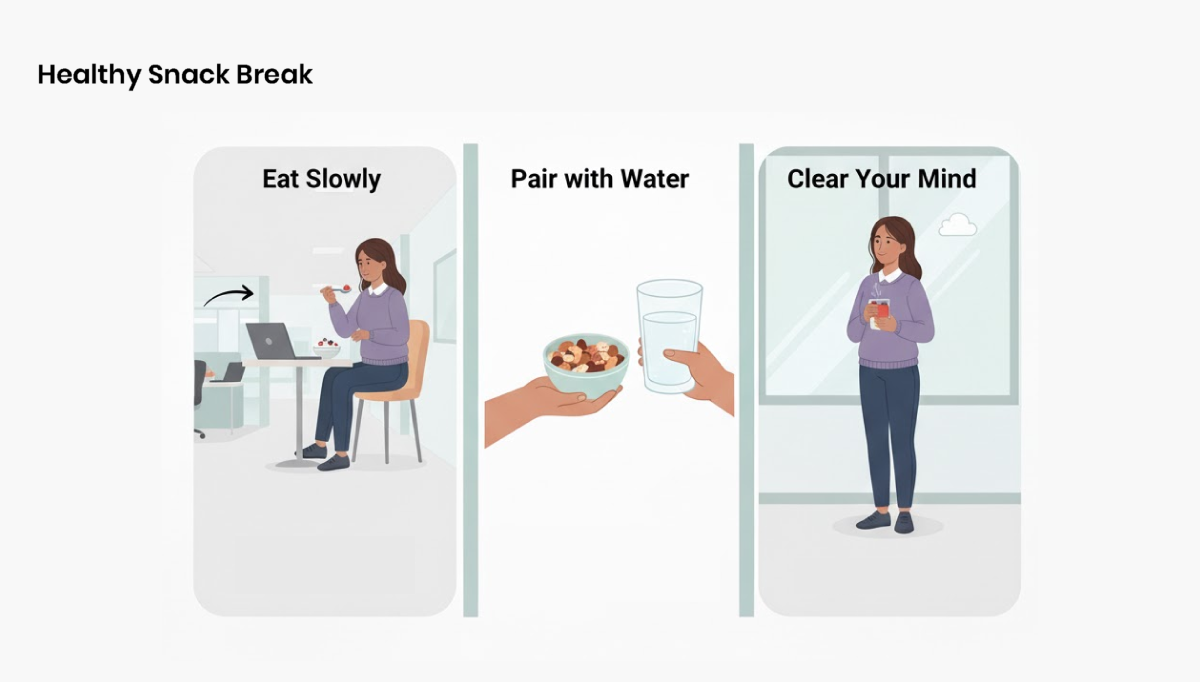
What is it: It is a practice where employees actively eat something healthy, such as fruit, nuts, or yogurt, while taking a break from work.
How to do:
-
Eat slowly, away from the work screen.
-
Pair nuts with water for a balanced reset.
Benefits:
-
Stabilizes blood sugar levels.
-
Boosts concentration at work.
-
Instills better dietary habits.
Rollout tips for HR:
- Stock healthy snack baskets or partner with vendors to deliver snack hamper boxes during wellness weeks.
Accessibility/safety note:
Provide gluten-free, nut-free, and vegan options. This way, everyone has access to healthy snacks irrespective of any health issues.
8. Mindfulness meditation
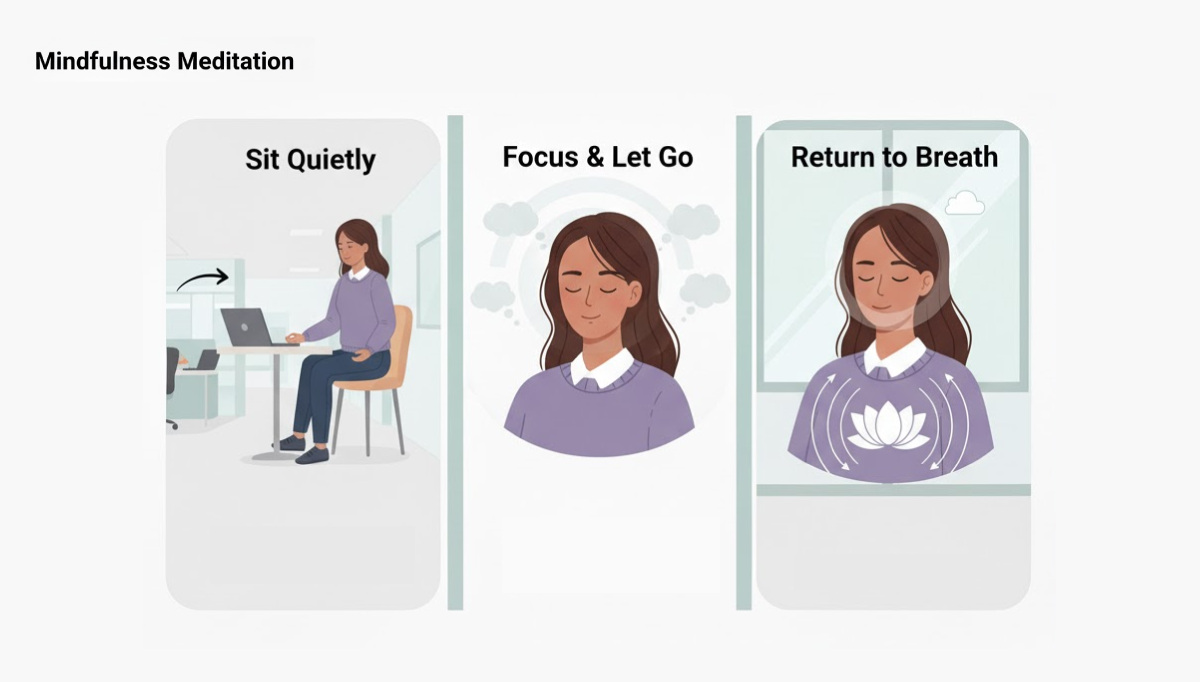
What is it: A short meditation activity to center the mind.
How to do:
-
Sit quietly and close your eyes.
-
Focus on your breath or a calming mantra.
-
Let thoughts pass without judgment.
-
Return to breath for 3–5 minutes.
Benefits:
-
Reduces stress and burnout.
-
Improves emotional balance.
-
Boosts resilience under pressure.
Rollout tips for HR:
Share guided meditation audios or schedule "Mindful Mondays." Introduce guided mindfulness meditation sessions, as in Vantage Fit's, for better response.
9. Quick art and craft
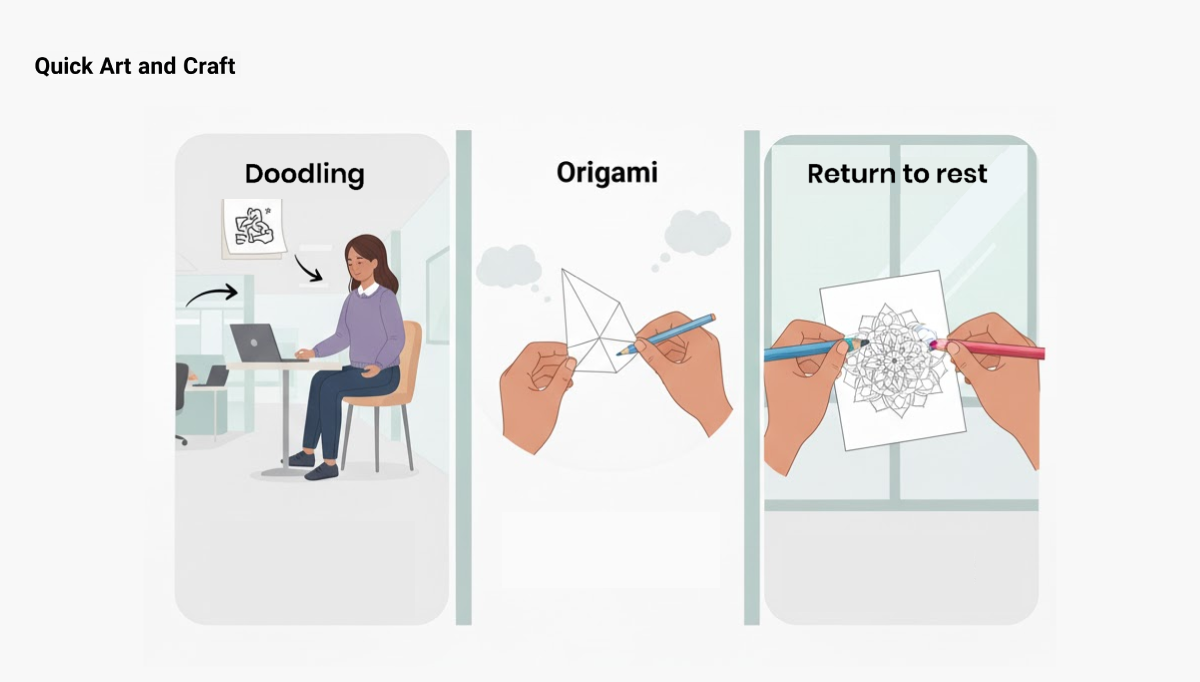
What is it: A short, 5-minute wellness activity where employees engage in simple art or craft activities. The activity can include activities such as doodling, origami, or coloring. It is not about showcasing creative skills, but about expression and relaxation.
How to do:
-
Provide basic supplies such as paper, markers, sticky notes, or coloring sheets.
-
Set aside 5 to 10 minutes during breaks or at the end of a meeting for this activity.
-
Activities can include doodling something that represents the mood of the day, folding a simple origami shape, coloring a mandala or pattern, or making a quick gratitude card.
-
Encourage employees to share their creations (optional) for fun and bonding.
Benefits:
-
Reduces stress by activating the brain's creative side.
-
Encourages mindfulness and helps employees reset mentally.
-
Boosts morale and team connection when shared in groups.
-
Enhances focus and productivity after short creative breaks.
Rollout tips for HR:
-
Add "5-Minute Creativity Breaks" to wellness calendars.
-
Provide digital coloring templates or origami instructions for remote teams.
-
Create a themed challenge (e.g., "Doodle Your Weekend Plan Fridays") to spark engagement.
-
Encourage managers to kick off team meetings with a one-minute doodle exercise.
Accessibility/safety note:
-
Activities should be optional, and employees should not feel pressured to participate. Emphasize the fun part rather than artistic skills. This way, the chances of a higher participation rate will be greater.
-
Provide both digital and paper-based options for inclusivity.
-
Ensure non-toxic, safe materials are used when distributing physical supplies.
10 Brain teasers
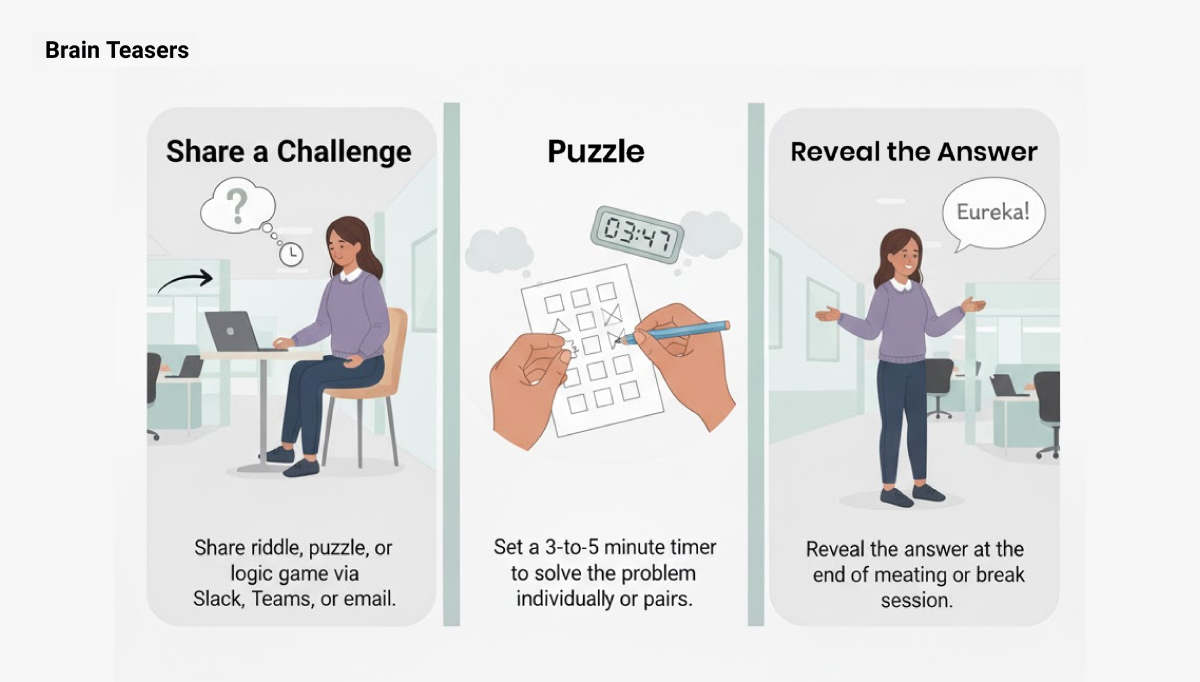
What is it: These involve short puzzles, riddles, or mental challenges that employees can solve in under 5 minutes. They engage in critical thinking, spark creativity, and provide a refreshing break from routine tasks.
How to do:
-
Share a riddle, puzzle, or logic game via Slack, Teams, or email.
-
Set a 3- to 5-minute timer for employees to solve the problem individually or in pairs.
-
Reveal the answer at the end of a meeting or break session.
Examples include: Word scrambles, Sudoku mini grids, Pictionary, and Riddles or "what am I?" questions
Benefits:
-
Boosts problem-solving skills.
-
Improves memory and focus.
-
Encourages team spirit if solved in pairs or groups.
-
Provides fun stress relief while staying mentally engaged.
Rollout tips for HR:
-
Introduce "Mindful Monday" or "Trivia Thursday" with a quick brain teaser.
-
Include puzzles in the wellness newsletter, if any.
-
Organize mini competitions with incentives to increase participation.
-
Pair teasers with short breaks to re-energize employees after long meetings.
Accessibility/safety note:
-
Offer a mix of visual and verbal puzzles to accommodate different thinking styles.
-
Keep challenges short and light to avoid frustration or cognitive overload.
-
Make participation optional to respect varying preferences.
Desk push-ups or chair squats
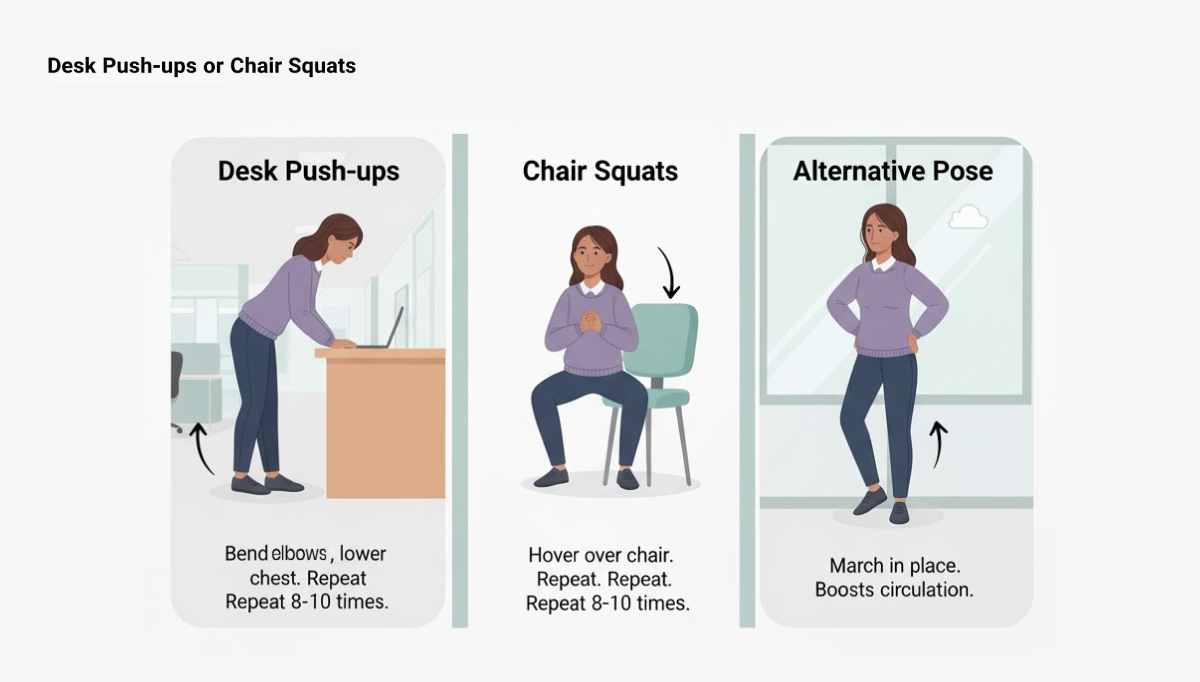
What is it: A quick bodyweight exercise that employees can do right at their workstation to get their blood flowing. These simple moves also work as muscle and core strengthening activities.
How to do desk push-ups:
-
Stand an arm's length away from your desk.
-
Place your palms flat on the desk, with your hands shoulder-width apart.
-
Step back slightly, keeping your body in a straight line.
-
Bend your elbows to lower your chest toward the desk.
-
Push back up and repeat 8 to 10 times.
How to do Chair Squats:
-
Stand in front of your chair with your feet hip-width apart.
-
Slowly lower your body as if you are sitting down, but hover just above the chair.
-
Keep your chest lifted and keep your feet firmly on the ground.
-
Hold for 2 seconds, then return to your standing position.
-
Repeat 8 to 10 times.
Benefits:
-
Boosts circulation and reduces stiffness caused by prolonged sitting.
-
Strengthens muscles in the arms, legs, and core.
-
Increases mental energy.
-
Improves posture by engaging stabilizing muscles
Rollout tips for HR:
-
Encourage teams to have a quick "movement break" before or after long meetings.
-
Share a short demo video or GIF on official communication channels.
-
Create a "5-minute strength challenge" during wellness weeks or Wellness Wednesdays.
-
For remote workers, add it as an icebreaker in virtual meetings.
Accessibility/safety note:
-
Offer alternatives, such as wall push-ups or seated leg lifts, for employees with mobility issues.
-
Remind participants to move slowly and within their comfort range.
-
Ensure desks and chairs are stable and non-rolling.
Social connection break
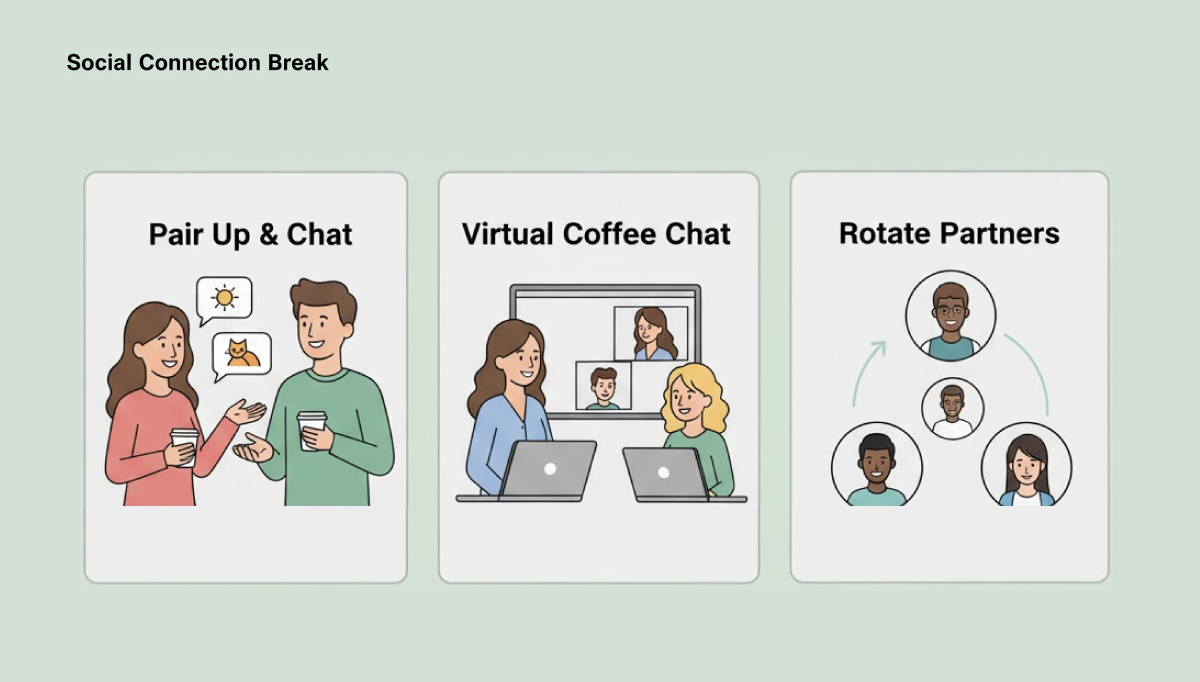
What is it: A short 5-minute break in the workday where employees intentionally step away from tasks to connect with a colleague. These micro-conversations build camaraderie and reduce workplace isolation.
How to do:
-
Pair up with a teammate (in-person or virtually), or allow employees to pair up on their own.
-
Spend 5 minutes chatting about non-work topics like hobbies, weekend plans, or favorite shows.
-
If remote, use Slack / Teams for "coffee chat" bots or breakout rooms.
-
Rotate partners weekly to strengthen cross-team bonds, if possible.
Benefits:
-
Helps to have a mental reset.
-
Strengthens workplace relationships and improves team cohesion.
-
Boosts morale by creating a sense of belonging.
-
Improves collaboration as stronger bonds make communication more effective and smoother.
Rollout tips for HR:
-
Launch a "5-Minute Coffee Chat" program where employees are auto-paired weekly.
-
Dedicate a Slack/Teams channel for casual check-ins.
-
Encourage managers to lead the way in participation.
-
Integrate into wellness weeks or Employee Wellness Days as a recurring activity.
Accessibility/safety note:
-
Allow employees to participate voluntarily, respecting those who prefer quiet breaks.
-
Offer both virtual and in-person options for hybrid teams.
-
Encourage inclusive conversations by suggesting light, neutral prompts (e.g., "What's your favorite comfort food?").
Benefits of 5-minute wellness activities
I came across a research paper that studies micro breaks and their impact on well-being. Based on that paper, here are some benefits of 5-minute wellness activities that are worth mentioning:
For employees:
-
Higher energy and focus: A short 5-minute break can refresh the cognitive state to a great extent. It helps employees to resume their work with more energy and focus. The research shows micro breaks help reset mental focus and sustain vitality throughout the day.
-
Reduced stress and burnout: The study suggests that even a 30-second wellness break can improve mental resilience and help prevent the gradual burnout that accumulates during long work sessions.
-
Better posture and long-term health: Certain wellness activities, such as chair yoga or other desk stretching exercises, are scientifically proven to improve poor sitting postures. Additionally, they boost blood circulation and even strengthen muscles.
-
More positivity and morale: The research also suggests that stretching exercises can induce positive emotions, ultimately boosting morale.
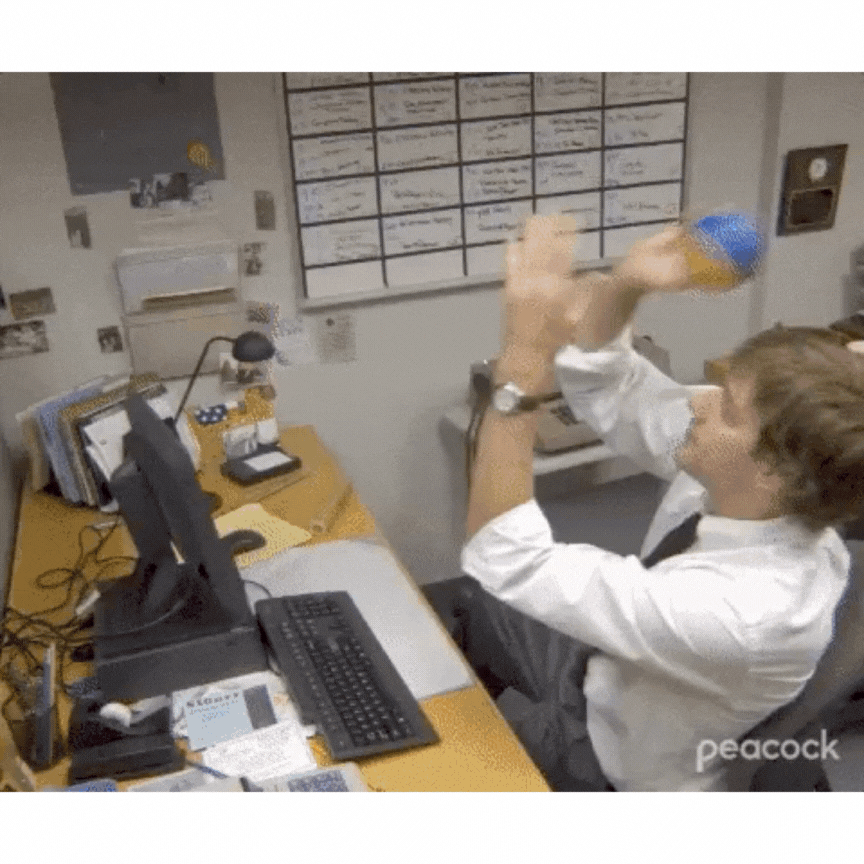
For employers & HR:
As employees feel less stressed and gain focus at work, after practicing 5-minute activities, they will be able to deliver the following:
-
Improved productivity and engagement
-
Lower absenteeism
-
Stronger retention rates
-
Demonstrates commitment to employee well-being
Tips to Encourage Employee Adoption
-
Lead by example: Encourage managers to set examples and take such micro breaks.
-
Gamify wellness: Introduce 5-minute activities as part of the wellness challenges. Utilize wellness platforms like Vantage Fit to track participation and celebrate milestones.
-
Host wellness events: Feature a "5-minute break" session during Wellness Wednesdays, Employee Wellness Day, or corporate wellness workshops. Let employees experience the power of microbreaks before formally integrating them into a wellness program.
-
Communicate ROI: Share data on how micro breaks are helping employees globally. Let employees and leadership understand how these micro-breaks reduce stress and improve performance.
Key Takeaways
- Microbreaks are evidence-backed, low-cost, and easy-to-scale initiatives.
- Offer a simple menu of physical, mental, and team breaks that everyone can customize to suit their individual needs.
- Use reminders, short assets (such as videos or GIFs) to embed habits.
Final Thoughts
Well-being activities seem interesting from afar. When you introduce them to a group of individuals as part of their daily routine, some will readily accept it, while others will avoid it.
One of the primary reasons some people avoid well-being activities is that they tend to get bored easily. And others do not realize the essence of wellness activities.
This is why 5-minute wellness activities, such as chair yoga and brain teaser games, can slowly garner your employees' attention and interest. Moreover, these 5-minute wellness activities prove that well-being doesn't need to disrupt work.
It can be easily integrated into the daily routine. Normalize micro-breaks, and you'll foster a culture of care, boost productivity, and make wellness a daily habit rather than an annual event.
Frequently Asked Questions
1. Do wellness activities really work if they're this short?
Yes. A case study demonstrates that 5-minute wellness breaks can improve vigor, reduce fatigue, and enhance performance at work.
2. How often should employees take a wellness break?
Short breaks every 50 to 90 minutes, or a five-minute break every hour. This is particularly essential for individuals who spend a lot of time working on screens. Even 1 to 3-minute micro-breaks every 30 to 60 minutes show improvements in cognitive and musculoskeletal health.
3. How can you integrate these activities without disrupting work?
Schedule micro-breaks before and after hectic meeting schedules. Encourage participation by introducing incentives.
4. Are these activities suitable for both remote and office employees?
Yes. All activities are desk-friendly and require no or minimal materials to perform.
5. What are some ideas for office fitness challenges?
Some popular office fitness challenge ideas include a step challenge, stair climbing challenge, and a 7-minute workout challenge.
6. What are some wellness challenge ideas for employees?
Some of the most effective wellness challenge ideas for employees include the sugar detox challenge, the no-screens-after-8-pm challenge, and the gratitude challenge, among others.

